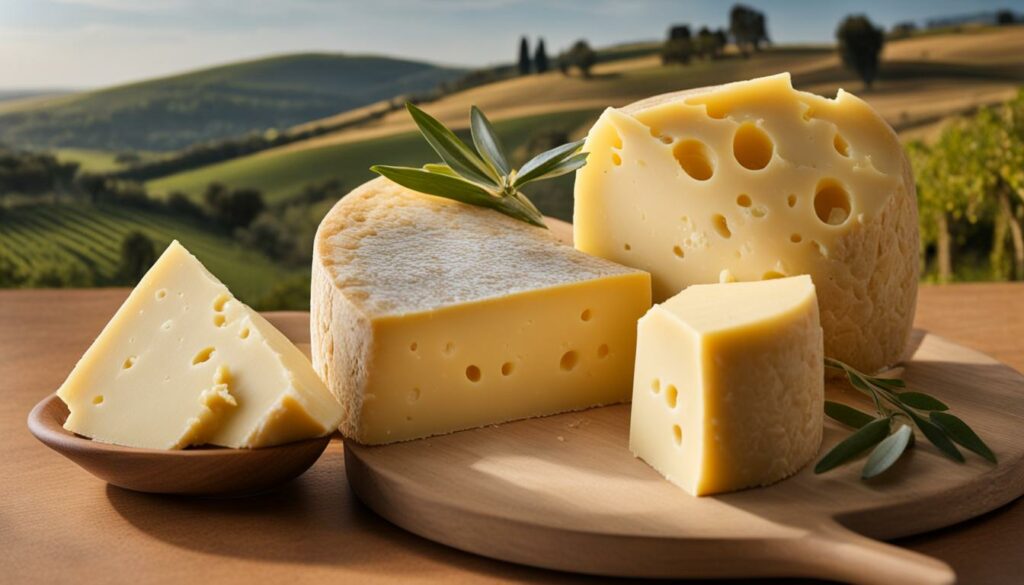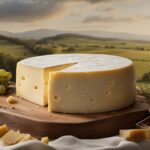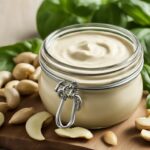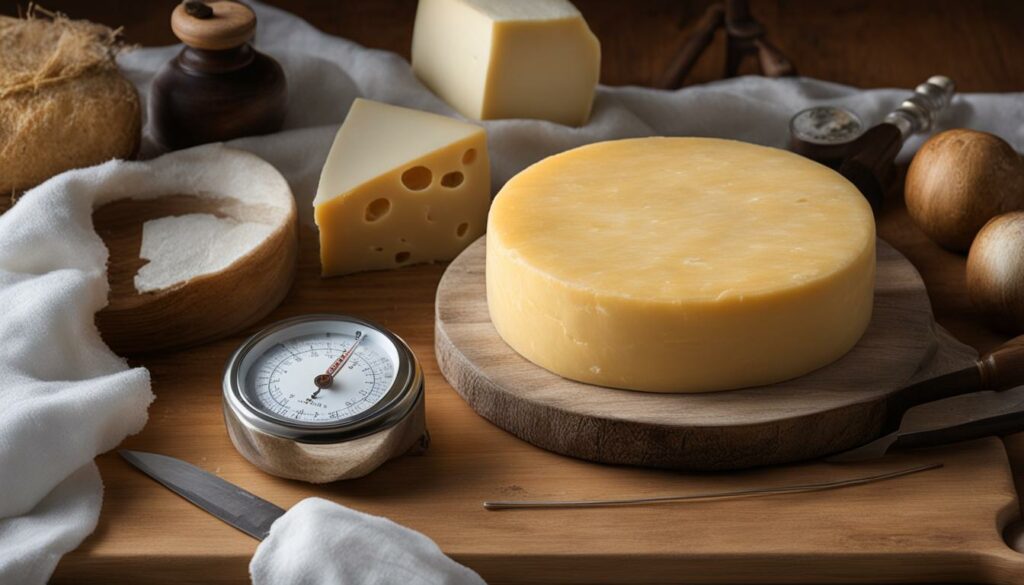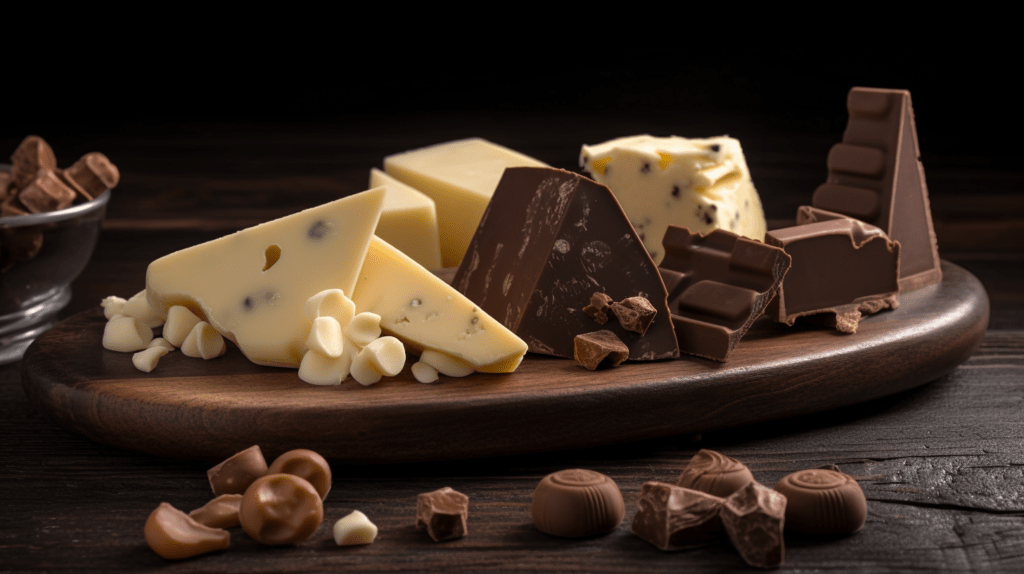Welcome to the world of Canestrato cheese, a true Italian delicacy that will take your taste buds on a journey through the flavors of Italy. Made from sheep’s milk and aged to perfection, Canestrato cheese is a traditional favorite that embodies the essence of Italian cheese-making.
With its roots in the region of Puglia, Canestrato cheese is a proud representative of the rich cheese-making heritage that Italy is known for. It is a versatile cheese that can be enjoyed in various ways, from the table to the kitchen.
As a cheese enthusiast, you’ll appreciate the diverse range of flavors and textures that Canestrato cheese offers. From its smooth and creamy profile to its delightful nutty undertones, every bite is a symphony of taste.
Whether you’re a connoisseur of cheese varieties or simply someone who appreciates the fine art of traditional cheese-making, Canestrato is sure to impress. Its unique combination of sheep’s milk, aging process, and artisan craftsmanship make it a standout option in the world of gourmet cheeses.
Join us on this culinary adventure as we explore the history, varieties, flavors, and characteristics of Canestrato cheese. Discover what makes this Italian delicacy a true gem in the world of cheese.
The History and Varieties of Canestrato Cheese
Canestrato cheese has a rich history and comes in different varieties throughout Italy. While it is often compared to Pecorino Romano and Ragusano, Canestrato has its own unique flavor profile that sets it apart. This traditional Italian cheese can be made from whole cow’s milk or a mix of cow, goat, and sheep’s milk, resulting in variations in taste and texture.
Depending on the region, Canestrato cheese may have different names. In Sicily, for example, it is known as Pecorino Siciliano. Each variation showcases the local terroir and traditional cheese-making techniques, making Canestrato a true reflection of the diverse culinary heritage of southern Italy and its islands, such as Sicily and Sardinia.
Cheese Varieties:
- Canestrato made with cow’s milk
- Canestrato made with goat’s milk
- Canestrato made with sheep’s milk
- Canestrato made with a combination of cow, goat, and sheep’s milk
Each variety has its own distinct characteristics, from mild and creamy to rich and tangy flavors. Canestrato cheese can be enjoyed at various stages of maturity, ranging from young and soft to aged and firm, which intensifies the flavor. It is a versatile cheese that can be used in a wide range of dishes or enjoyed on its own with crusty bread and a glass of wine.
Canestrato cheese captures the essence of southern Italy’s cheese-making traditions, showcasing the craftsmanship and dedication of the local cheesemakers. Whether you prefer a young Canestrato with fresh, subtle flavors or an aged one with a robust and complex taste, you’ll discover a cheese that epitomizes the rich culinary heritage of Italy’s vibrant south.
To give you a visual impression of the various Canestrato cheese varieties, take a look at the following table:
| Variety | Description | Flavor |
|---|---|---|
| Canestrato made with cow’s milk | Made exclusively with cow’s milk, offering a creamy and mellow taste | Mild and creamy |
| Canestrato made with goat’s milk | Infused with the distinct flavors of goat’s milk, creating a unique tanginess | Tangy and slightly sharp |
| Canestrato made with sheep’s milk | Made entirely with sheep’s milk, resulting in a bold and earthy profile | Rich and robust |
| Canestrato made with a combination of cow, goat, and sheep’s milk | A blend of different milks, offering a balanced and complex flavor | Harmonious and layered |
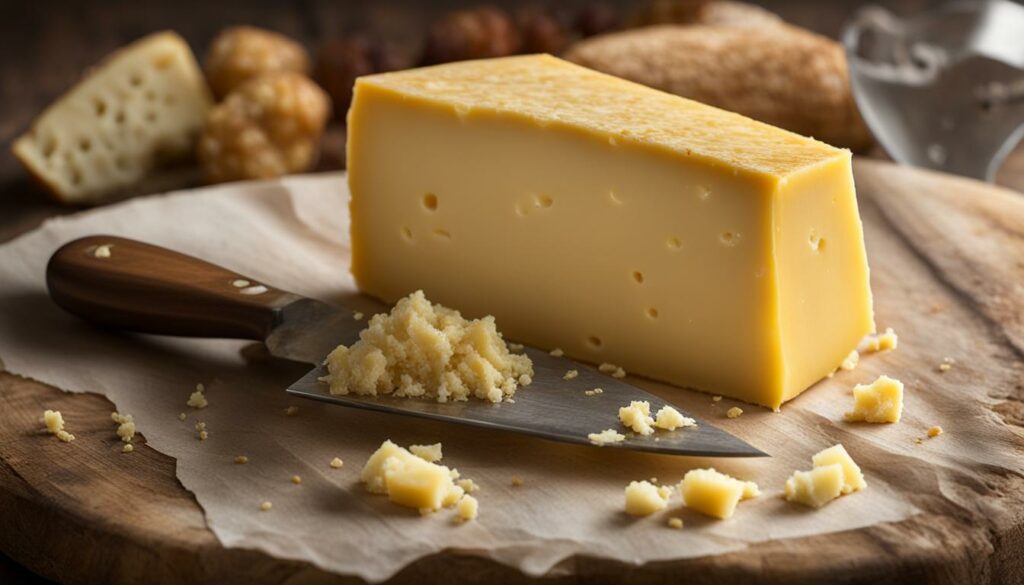
The Making of Canestrato Cheese
Making Canestrato cheese is a fascinating and intricate process that requires skill and precision. This beloved Italian cheese can be made using different types of milk, including cow’s milk, ewe’s milk, goat’s milk, or a combination of these. Each milk imparts a unique flavor and texture to the final cheese.
The journey of Canestrato cheese begins by acidifying and heating the milk to a specific temperature. This step helps to create the ideal environment for the growth of beneficial bacteria, which contribute to the cheese’s flavor development.
Next, rennet is added to coagulate the milk, forming curds. The curds are then cut into specific sizes to release the whey. This process helps to separate the liquid from the solid components of the milk. The whey is then drained, leaving behind the curds that will eventually turn into Canestrato cheese.
Once the curds have been separated, they are molded into traditional basket shapes, which give the cheese its distinctive appearance. The curds are then pressed to remove any remaining whey, ensuring a firm and compact texture.
After pressing, the cheese enters the salting and aging process, which is crucial for developing its unique flavor and texture. Canestrato cheese is typically salted by hand, allowing the salt to penetrate the cheese evenly. The cheese is then aged for a specific period, ranging from a few months to several years, depending on the desired flavor profile.
“The cheese-making process is a labor of love, with attention paid to every detail. From selecting the milk to aging the cheese, each step contributes to the creation of the exceptional Canestrato.”
The result is a cheese with a pronounced flavor and texture that reflects the characteristics of the milk used. Canestrato cheese made with cow’s milk tends to be milder and creamier, while ewe’s milk imparts a richer and more robust flavor. Goat’s milk adds a distinct tanginess to the cheese, creating a unique taste experience.
Canestrato cheese is a true testament to the artistry of cheese making and the craftsmanship of Italian cheesemakers. Whether enjoyed on its own, paired with other foods, or used in recipes, Canestrato cheese is a culinary delight that brings the authentic flavors of Italy to your table.
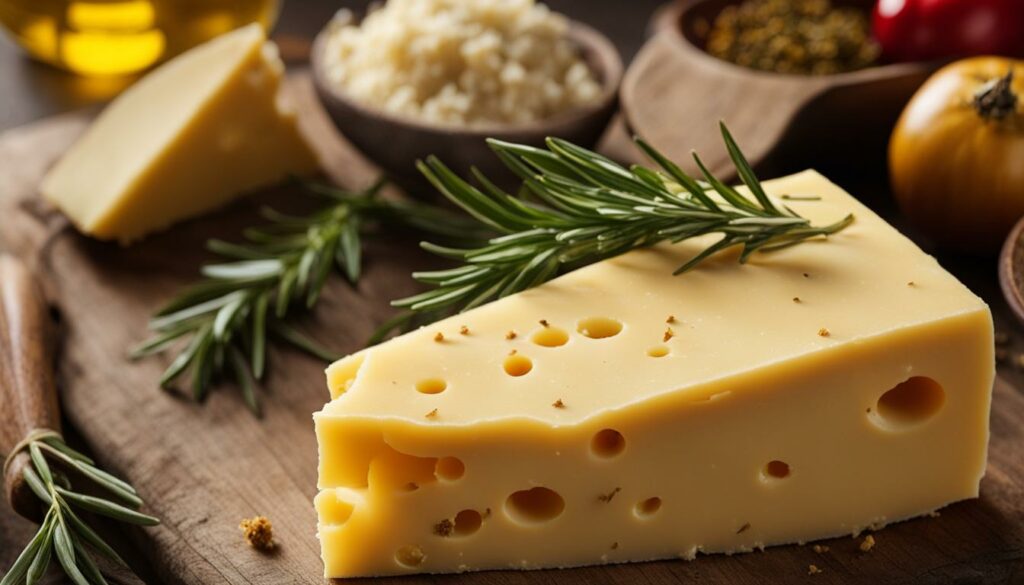
| Type of Milk | Flavor | Texture |
|---|---|---|
| Cow’s Milk | Milder, Creamier | Smooth, Buttery |
| Ewe’s Milk | Rich, Robust | Firm, Dense |
| Goat’s Milk | Tangy, Zesty | Crumbly, Creamy |
The Flavors and Characteristics of Canestrato Cheese
Canestrato cheese offers a delightful range of flavors and distinctive characteristics that make it a true culinary treasure. Whether enjoyed on its own or incorporated into your favorite dishes, this Italian delicacy is sure to tantalize your taste buds.
When fresh, Canestrato cheese has a sweet and delicate flavor profile that is complemented by a slight tanginess. This combination creates a unique taste experience that is both satisfying and refreshing. As the cheese ages, it undergoes a transformation, developing more complex flavors and a firmer texture. This aging process adds depth and richness to the cheese, making it even more delectable.
One popular variation of Canestrato cheese is the Pepato, which incorporates the addition of peppers. This variation introduces a delightful spiciness that adds a new dimension to the cheese’s taste profile. The spiciness of the Pepato perfectly balances with the natural sweetness of the cheese, creating a harmonious blend of flavors.
Canestrato cheese offers a range of flavors, from sweet and tangy to spicy, making it a versatile choice for various culinary creations. Its unique characteristics make it a favorite among cheese connoisseurs. The thick outer rind, bearing the pattern of the traditional woven basket, adds to the cheese’s charm and authenticity.
To fully appreciate the flavors and characteristics of Canestrato cheese, it’s best enjoyed slowly, allowing its aromas and tastes to unfold on your palate. Serve it with your favorite crackers, fresh fruits, or as a topping for salads and pasta dishes. No matter how you choose to savor it, Canestrato cheese is sure to elevate any meal to new heights of deliciousness.
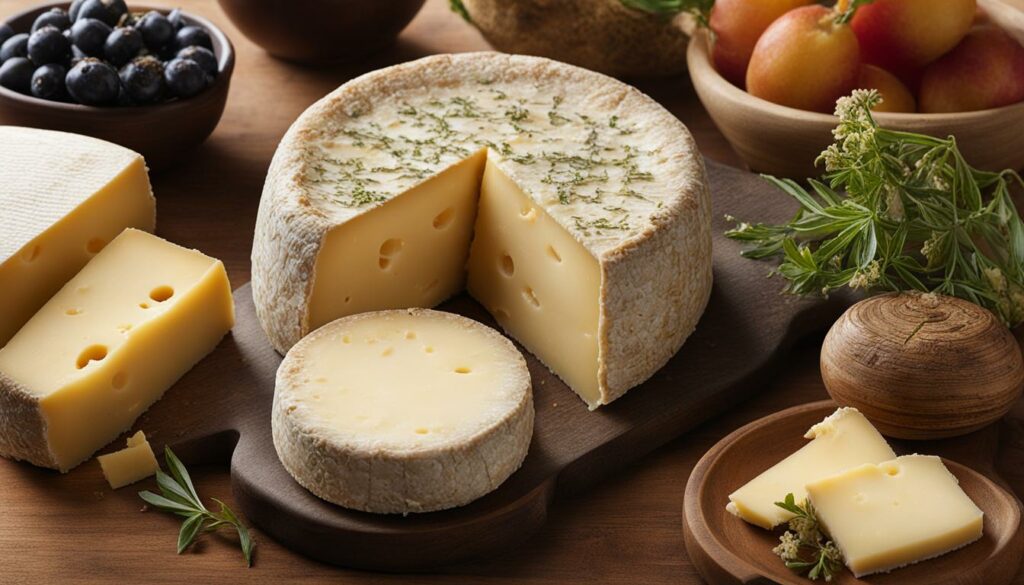
Let’s explore the fascinating history and production process of Canestrato cheese in the next section and discover more about this culinary gem.
Canestrato Cheese: A True Delicacy from Sicily
Canestrato cheese from Sicily is a prized delicacy that embodies the rich traditions of Italian cheesemaking. Crafted with care and passion, this traditional cheese is made using a combination of sheep and cows milk, resulting in a unique flavor profile that is sweet and delicate.
Produced by small farms in Sicily, Canestrato cheese is a testament to the commitment and expertise of local cheesemakers. These farms specialize in breeding specific types of sheep and cows to ensure the highest quality milk, which is then transformed into this exquisite cheese. The result is a distinct and refined flavor that sets Sicilian Canestrato apart from other cheeses.
Canestrato cheese is a popular choice for those who appreciate the artistry of Italian cheese-making. Its smooth texture and mild yet flavorful taste make it a versatile option for any cheese lover. This delicacy can be enjoyed as a table cheese, perfect for pairing with fruits, nuts, and wine for a delightful cheeseboard experience.
As with many traditional cheeses, Canestrato cheese has its roots in the Italian casearia tradition, which emphasizes the use of high-quality ingredients and time-honored techniques. The combination of sheep and cow’s milk adds depth and complexity to the cheese, making it a true indulgence for the palate.
The Making of Canestrato Cheese in Sicily
The process of crafting Canestrato cheese in Sicily follows the Italian casearia tradition with meticulous attention to detail. Here’s an overview of the cheese-making process:
- Milk Collection: High-quality sheep and cows milk are carefully collected from local farms.
- Curd Formation: The milk is acidified and heated to a specific temperature, allowing the curd to form.
- Curd Cutting: The curd is cut into specific sizes to release the whey and develop the desired texture.
- Molding and Pressing: The curds are carefully molded and pressed to shape the cheese and remove excess moisture.
- Salting and Aging: The cheese is then salted and aged to develop its characteristic flavors and textures over time.
The result is a cheese that reflects the rich cheese-making heritage of Sicily and the dedication of its talented artisans. It is a true testament to the flavors and traditions that have been passed down from generation to generation.
| Canestrato Cheese Variety | Origin | Flavor | Texture |
|---|---|---|---|
| Canestrato di Moliterno | Moliterno, Italy | Rich and intense | Firm and crumbly |
| Canestrato di Filiano | Filiano, Italy | Nutty and savory | Firm and slightly elastic |
| Canestrato di Sogliano | Sogliano al Rubicone, Italy | Complex and sharp | Hard and granular |
“Canestrato cheese from Sicily is a true delicacy, cherished for its sweet and delicate taste. Made using a combination of sheep and cows milk, it captivates the senses with its distinct flavors. Indulge in a piece of Sicilian Canestrato cheese and savor the craftsmanship and traditions of Italian cheesemaking.”
With its deep roots in the Italian casearia tradition, Canestrato cheese from Sicily represents the epitome of traditional cheese craftsmanship. Its exceptional taste and refined flavors make it a delicacy that is treasured and celebrated. Whether enjoyed on its own or paired with other delicious ingredients, Canestrato cheese is a testament to the rich culinary heritage of Sicily and a must-try for cheese enthusiasts.
Canestrato Cheese: A Recipe for Making at Home
Making Canestrato cheese at home is a rewarding culinary experience that allows you to savor the authentic flavors of this Italian delicacy. While traditionally made with ewe’s milk, you can also use cow’s milk, goat’s milk, or a combination of these milks to create your homemade Canestrato cheese.
Follow this simple recipe to embark on your cheese-making journey:
- Acidify and heat the milk: Start by heating the milk to a specific temperature. Then, add an acidifying agent like lemon juice or vinegar to the milk to create the optimal environment for coagulation.
- Add rennet to coagulate the curd: Once the milk is acidified, add rennet to help coagulate the curd. This will give the cheese its characteristic texture and structure.
- Cut the curd: After the curd has formed, cut it into small pieces to release the whey. This step helps further develop the desired texture of Canestrato cheese.
- Cook the curds: Place the curds in a pot and gently heat them while stirring. This process helps remove additional whey and enhances the cheese’s flavor and consistency.
- Mold and press the cheese: Once the curds have reached the desired texture, carefully mold and press them to give the cheese its shape. This step helps to remove any remaining whey and solidify the cheese.
- Aging the cheese: Canestrato cheese is typically aged to enhance its flavor and develop its unique characteristics. You can choose to age your homemade cheese for a few weeks or even several months, depending on your preference.
Once fully aged, your homemade Canestrato cheese can be enjoyed on its own as a table cheese or used in various culinary creations. Its slightly tangy and robust flavor pairs well with a variety of dishes, making it a versatile addition to your kitchen.
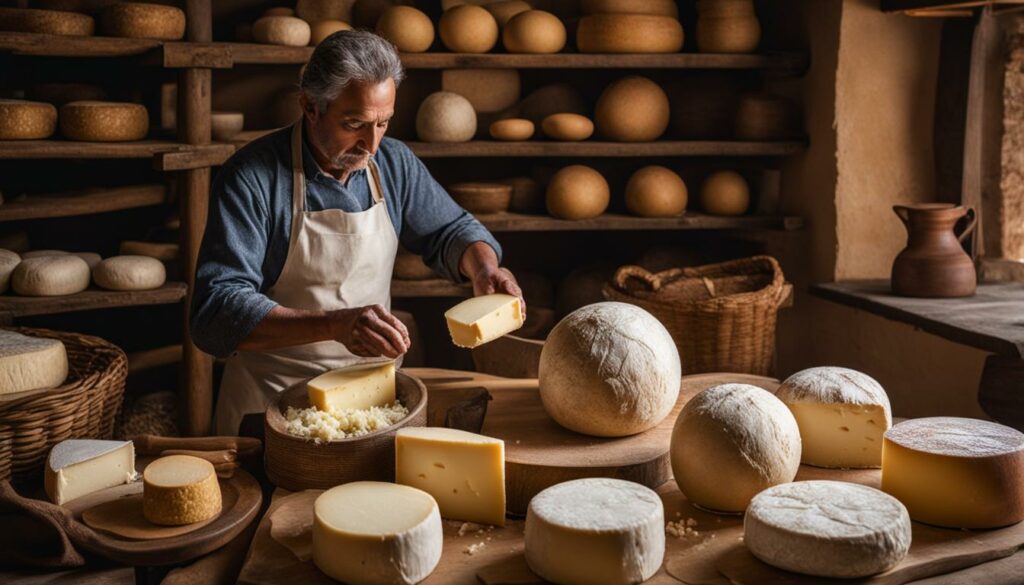
| Ingredients | Amount |
|---|---|
| Ewe’s milk or a combination of cow’s, goat’s, and ewe’s milk | 4 liters |
| Lemon juice or vinegar | 2 tablespoons |
| Rennet | 1/2 teaspoon |
| Salt | To taste |
Get ready to embark on a cheese-making adventure in your own kitchen. With this simple recipe, you can create your own delicious Canestrato cheese and impress your family and friends with your culinary skills. Enjoy the process and savor the unique flavors of this Italian delicacy!
Conclusion
Canestrato cheese is a true Italian delicacy that embodies the rich culinary heritage of Puglia. Made from the finest sheep’s milk and aged to perfection, this traditional cheese offers a gourmet experience like no other. Whether enjoyed on a cheese board or added to your favorite recipes, Canestrato cheese brings an artisan touch to every dish.
The flavors of Canestrato cheese are a testament to the artistry of Italian cheese-making. With its unique taste and characteristics, this delicacy has captured the hearts of cheese connoisseurs around the world. Its rich, tangy profile pairs perfectly with a variety of accompaniments, making it a versatile choice for any occasion.
Indulge in the true taste of Italy with Canestrato cheese. From its storied history to its unrivaled flavors, this Italian gem is a must-try for any gourmet enthusiast. Savor the exquisite flavors of Canestrato and elevate your culinary creations with a touch of tradition and authenticity.
FAQ
What is Canestrato cheese?
Canestrato cheese is a traditional Italian delicacy from the region of Puglia. It is made from sheep’s milk and is known for its rich flavors and unique taste.
How is Canestrato cheese made?
Making Canestrato cheese involves a specific cheese-making process. It can be made with cow’s milk, ewe’s milk, or goat’s milk, or a combination of these milks. The milk is first acidified and heated to a specific temperature. Then, rennet is added to coagulate the curd. The curd is cut into specific sizes and cooked to remove whey. The curds are then molded and pressed. After pressing, the cheese undergoes a salting and aging process to develop its unique flavor and texture.
What are the flavors and characteristics of Canestrato cheese?
Canestrato cheese has a range of flavors and characteristics. When fresh, it has a sweet and delicate flavor that tends to be slightly tangy. As the cheese ages, it develops more complex flavors and a firmer texture. The Pepato variation, which is made with the addition of peppers, has a spicier taste. The cheese is often known for its thick outer rind that bears the pattern of the traditional woven basket it is made in.
Where does Canestrato cheese come from?
Canestrato cheese is a traditional cheese from the region of Puglia in southern Italy. It is also made in other regions of Italy, such as Sicily and Sardinia, where it may have different names like Pecorino Siciliano.
Can I make Canestrato cheese at home?
Yes, making Canestrato cheese at home is possible with a simple recipe. While traditionally made with ewe’s milk, it can also be made with cow’s milk or goat’s milk, or a combination of these milks. The cheese-making process involves acidifying and heating the milk, adding rennet to coagulate the curd, cutting the curd, cooking the curds, and molding and pressing the cheese. The cheese can be aged to develop its flavor further.

